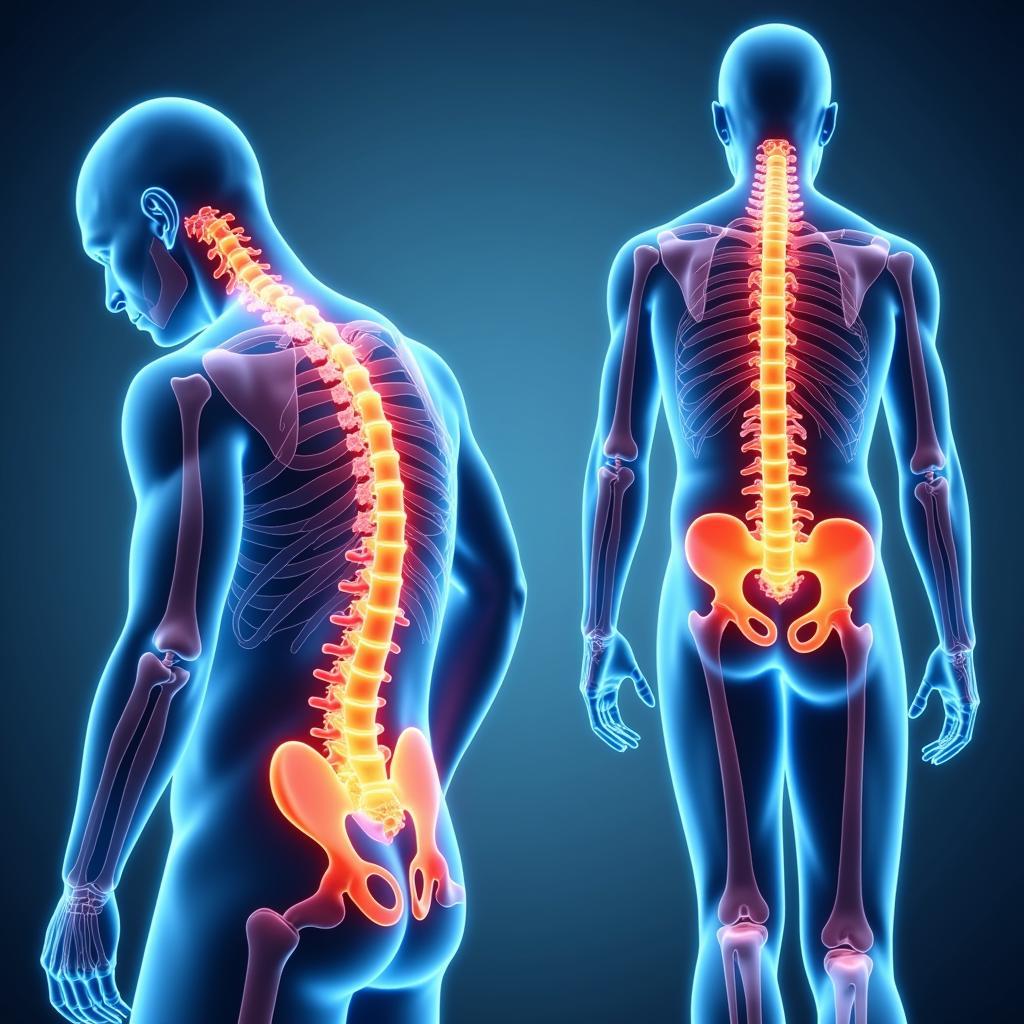Axial Spa, a term often misunderstood, refers to a specific type of chronic inflammatory arthritis primarily affecting the spine and sacroiliac joints. It can cause significant pain and stiffness, impacting mobility and overall well-being. This article delves into the complexities of axial spa, exploring its symptoms, diagnosis, and available treatment options.
Understanding the nature of axial spa is crucial for effective management. This condition, characterized by inflammation in the spine and sacroiliac joints, often begins with subtle symptoms that can be easily overlooked. Early diagnosis and intervention are essential to prevent irreversible damage and improve long-term outcomes.
What are the Symptoms of Axial Spa?
The most common symptom of axial spa is lower back pain, which can be persistent and worsen at night or during periods of inactivity. Stiffness in the spine is another hallmark symptom, often more pronounced in the morning and improving with movement. Other symptoms can include fatigue, tenderness in the buttocks, and pain in the heels or other joints.
What causes these symptoms? The underlying inflammation associated with axial spa can lead to the formation of new bone in the spine, causing the vertebrae to fuse together over time. This fusion can restrict movement and contribute to the characteristic stiffness experienced by individuals with this condition.
 Axial Spa Symptoms Explained
Axial Spa Symptoms Explained
How is Axial Spa Diagnosed?
Diagnosing axial spa typically involves a combination of physical examination, imaging tests, and blood work. A physical exam will assess the range of motion in the spine and check for tenderness in the affected areas. Imaging studies, such as X-rays and MRI scans, can reveal changes in the spine and sacroiliac joints characteristic of the condition. Blood tests can detect the presence of HLA-B27, a genetic marker often associated with axial spa, although not everyone with this marker develops the condition. As explained in axial spa wiki, diagnosing this condition can be complex.
Early diagnosis is crucial for effective management. If you experience persistent back pain or stiffness, especially if it begins before the age of 45, it’s essential to consult a healthcare professional. Early intervention can help prevent disease progression and preserve joint function.
Exploring Treatment Options for Axial Spa
Treatment for axial spa focuses on managing pain, reducing inflammation, and maintaining mobility. A combination of medications, physical therapy, and lifestyle modifications are often employed to achieve these goals. Non-steroidal anti-inflammatory drugs (NSAIDs) are commonly used to relieve pain and inflammation.
In some cases, disease-modifying antirheumatic drugs (DMARDs) may be prescribed to slow the progression of the disease. Physical therapy plays a vital role in maintaining flexibility and strength, while regular exercise can help improve posture and reduce stiffness. Understanding the different stages of axial spa, like axial spa remission, is crucial for tailoring the right treatment approach.
Can Axial Spa Affect Other Parts of the Body?
While primarily affecting the spine and sacroiliac joints, axial spa can sometimes involve other joints, such as the hips, knees, or shoulders. It can also affect other parts of the body, causing inflammation in the eyes, lungs, or intestines. Understanding the potential for extra-articular manifestations is important for comprehensive management of the condition. For example, understanding how axial spa peripheral arthritis manifests can help manage the condition more effectively. Are there alternative treatment options? Some individuals explore alternative therapies, such as ayurveda treatment for axial spa, although further research is needed to determine their efficacy.
Living with Axial Spa: Tips for Managing the Condition
Living with axial spa can be challenging, but with proper management, individuals can maintain a good quality of life. Regular exercise, including stretching and strengthening exercises, is essential for maintaining mobility and reducing stiffness. Maintaining a healthy weight can also help reduce stress on the joints.
Additionally, practicing good posture and using supportive devices, such as ergonomic chairs and cushions, can help alleviate pain and improve comfort. Learning about the potential severity of the condition, such as when axial spa is severe, can empower individuals to seek appropriate medical attention.
In conclusion, axial spa is a chronic condition that requires ongoing management. Early diagnosis and intervention are crucial for preventing disease progression and improving long-term outcomes. By working closely with healthcare professionals and adopting a proactive approach to self-care, individuals with axial spa can lead fulfilling lives and maintain optimal well-being.
FAQ
- What is the difference between axial spa and ankylosing spondylitis?
- Can axial spa be cured?
- What are the long-term complications of axial spa?
- What types of exercises are recommended for axial spa?
- How can I manage axial spa flare-ups?
- Are there any dietary recommendations for managing axial spa?
- How can I find support groups for people with axial spa?
Need assistance? Contact us at Phone Number: 0373298888, Email: [email protected] or visit us at 86 Cau Giay, Hanoi. Our customer service team is available 24/7.